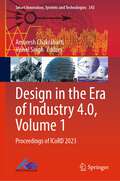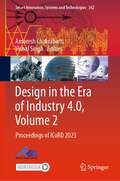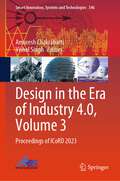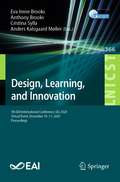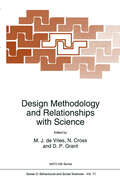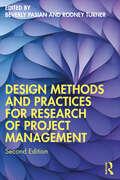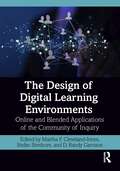- Table View
- List View
Design in Educational Technology: Design Thinking, Design Process, and the Design Studio (Educational Communications and Technology: Issues and Innovations #1)
by Brad Hokanson Andrew GibbonsThis book is the result of a research symposium sponsored by the Association for Educational Communications and Technology [AECT]. The fifteen chapters were developed by leaders in the field and represent the most updated and cutting edge methodology in the areas of instructional design and instructional technology. The broad concepts of design, design thinking, the design process, and the design studio, are identified and they form the framework of the book. This book advocates the conscious adoption of a mindset of design thinking, such as that evident in a range of divergent professions including business, government, and medicine. At its core is a focus on “planning, inventing, making, and doing.” (Cross, 1982), all of which are of value to the field of educational technology. Additionally, the book endeavors to develop a deep understanding of the design process in the reader. It is a critical skill, often drawing from other traditional design fields. An examination of the design process as practiced, of new models for design, and of ways to connect theory to the development of educational products are all fully explored with the goal of providing guidance for emerging instructional designers and deepening the practice of more advanced practitioners. Finally, as a large number of leading schools of instructional design have adopted the studio form of education for their professional programs, we include this emerging topic in the book as a practical and focused guide for readers at all levels.
Design in Motion: Applying Design Principles to Filmmaking
by Penny HiltonWith an abundance of information on how to create motion graphics already available, Design in Motion focuses on the why of moving image and less about the how. By unpacking the reasons behind screen designer's production choices, each chapter deconstructs examples of motion graphics by drawing on case studies of both familiar examples from contemporary cinema and unseen work from postgraduate motion graphic designers. It examines the value of image, text, motion, camera and transitions, explaining in detail why some methods work, while others fail. Whether you work in info-graphics, documentary or design, this book is structured to follow the production process and, together with its multimedia companion website, will be a by-your-side companion to guide you through your next project.
Design in Motion: Applying Design Principles to Filmmaking
by Penny HiltonWith an abundance of information on how to create motion graphics already available, Design in Motion focuses on the why of moving image and less about the how. By unpacking the reasons behind screen designer's production choices, each chapter deconstructs examples of motion graphics by drawing on case studies of both familiar examples from contemporary cinema and unseen work from postgraduate motion graphic designers. It examines the value of image, text, motion, camera and transitions, explaining in detail why some methods work, while others fail. Whether you work in info-graphics, documentary or design, this book is structured to follow the production process and, together with its multimedia companion website, will be a by-your-side companion to guide you through your next project.
Design in the Era of Industry 4.0, Volume 1: Proceedings of ICoRD 2023 (Smart Innovation, Systems and Technologies #343)
by Amaresh Chakrabarti Vishal SinghThis book showcases cutting-edge research papers from the 9th International Conference on Research into Design (ICoRD 2023) – the largest in India in this area – written by eminent researchers from across the world on design processes, technologies, methods and tools, and their impact on innovation, for supporting design for a connected world. The theme of ICoRD’23 has been ‘Design in the Era of Industry 4.0’. Industry 4.0 signifies the fourth industrial revolution. The first industrial revolution was driven by the introduction of mechanical power such as steam and water engines to replace human and animal labour. The second industrial revolution involved introduction of electrical power and organised labour. The third industrial revolution was powered by introduction of industrial automation. The fourth industrial revolution involves introduction of a combination of technologies to enable connected intelligence and industrial autonomy. The introduction of Industry 4.0 dramatically changes the landscape of innovation, and the way design, the engine of innovation, is carried out. The theme of ICoRD’23 - ‘Design in the Era of Industry 4.0’ –explores how Industry 4.0 concepts and technologies influence the way design is conducted, and how methods, tools, and approaches for supporting design can take advantage of this transformational change that is sweeping across the world. The book is of interest to researchers, professionals, and entrepreneurs working in the areas on industrial design, manufacturing, consumer goods, and industrial management who are interested in the new and emerging methods and tools for design of new products, systems, and services.
Design in the Era of Industry 4.0, Volume 2: Proceedings of ICoRD 2023 (Smart Innovation, Systems and Technologies #342)
by Amaresh Chakrabarti Vishal SinghThis book showcases cutting-edge research papers from the 9th International Conference on Research into Design (ICoRD 2023) – the largest in India in this area – written by eminent researchers from across the world on design processes, technologies, methods and tools, and their impact on innovation, for supporting design for a connected world. The theme of ICoRD’23 has been ‘Design in the Era of Industry 4.0’. Industry 4.0 signifies the fourth industrial revolution. The first industrial revolution was driven by the introduction of mechanical power such as steam and water engines to replace human and animal labour. The second industrial revolution involved introduction of electrical power and organised labour. The third industrial revolution was powered by introduction of industrial automation. The fourth industrial revolution involves introduction of a combination of technologies to enable connected intelligence and industrial autonomy. The introduction of Industry 4.0 dramatically changes the landscape of innovation, and the way design, the engine of innovation, is carried out. The theme of ICoRD’23 - ‘Design in the Era of Industry 4.0’ –explores how Industry 4.0 concepts and technologies influence the way design is conducted, and how methods, tools, and approaches for supporting design can take advantage of this transformational change that is sweeping across the world. The book is of interest to researchers, professionals, and entrepreneurs working in the areas on industrial design, manufacturing, consumer goods, and industrial management who are interested in the new and emerging methods and tools for design of new products, systems, and services.
Design in the Era of Industry 4.0, Volume 3: Proceedings of ICoRD 2023 (Smart Innovation, Systems and Technologies #346)
by Amaresh Chakrabarti Vishal SinghThis book showcases cutting-edge research papers from the 9th International Conference on Research into Design (ICoRD 2023) – the largest in India in this area – written by eminent researchers from across the world on design processes, technologies, methods and tools, and their impact on innovation, for supporting design for a connected world. The theme of ICoRD’23 has been ‘Design in the Era of Industry 4.0’. Industry 4.0 signifies the fourth industrial revolution. The first industrial revolution was driven by the introduction of mechanical power such as steam and water engines to replace human and animal labour. The second industrial revolution involved introduction of electrical power and organised labour. The third industrial revolution was powered by introduction of industrial automation. The fourth industrial revolution involves introduction of a combination of technologies to enable connected intelligence and industrial autonomy. The introduction of Industry 4.0 dramatically changes the landscape of innovation, and the way design, the engine of innovation, is carried out. The theme of ICoRD’23 - ‘Design in the Era of Industry 4.0’ –explores how Industry 4.0 concepts and technologies influence the way design is conducted, and how methods, tools, and approaches for supporting design can take advantage of this transformational change that is sweeping across the world. The book is of interest to researchers, professionals, and entrepreneurs working in the areas on industrial design, manufacturing, consumer goods, and industrial management who are interested in the new and emerging methods and tools for design of new products, systems, and services.
Design Leadership and Management: A Case Study in Singapore
by Garry Tan Anne ChapmanThis book explores issues in the development of the creative industries in Singapore, with a particular focus on the design sector. It presents case study research into the experiences of design leaders transitioning to leadership positions in the context of the Asia Pacific ‘war for talents’ and Singapore’s drive to become the design hub in Asia. Three in-depth case studies are provided: the case of design managers, the case of design consultants and the case of design entrepreneurs. The case studies reveal complex, inter-related issues and ideals that participants desired of potential designers and future design leaders as part of their transition to design leadership and management roles. The empirical findings of the research led to the generation of a new theory of design leaders’ transition to design leadership and management positions in Singapore, providing a framework for design career and trajectory. This book is significant for design education in Singapore, as well as internationally, because it establishes design leaders’ expectations of designer career trajectories, and the need for a design leadership pipeline. It will be of particular interest to designers and design leaders/managers; educational researchers; curriculum developers; and graduate and postgraduate design students.
Design, Learning, and Innovation: 5th EAI International Conference, DLI 2020, Virtual Event, December 10-11, 2020, Proceedings (Lecture Notes of the Institute for Computer Sciences, Social Informatics and Telecommunications Engineering #366)
by Eva Irene Brooks Anthony Brooks Cristina Sylla Anders Kalsgaard MøllerThis book constitutes the refereed post-conference proceedings the 5th EAI International Conference on DLI 2020, Design, Leaning and Innovation, which took place in December 2020. Due to COVID-19 pandemic the conference was held virtually. The 14 revised full papers presented were carefully selected from 40 submissions and are organized in four thematic sessions on: digital technologies and learning; designing for innovation; digital games, gamification and robots; designs for innovative learning.
Design, Make, Play: Growing the Next Generation of STEM Innovators
by Margaret Honey David E. KanterDesign, Make, Play: Growing the Next Generation of STEM Innovators is a resource for practitioners, policymakers, researchers and program developers that illuminates creative, cutting edge ways to inspire and motivate young people about science and technology learning. The book is aligned with the National Research Council’s new Framework for Science Education, which includes an explicit focus on engineering and design content, as well as integration across disciplines. Extensive case studies explore real world examples of innovative programs that take place in a variety of settings, including schools, museums, community centers, and virtual spaces. Design, Make, and Play are presented as learning methodologies that have the power to rekindle children’s intrinsic motivation and innate curiosity about STEM (science, technology, engineering, and mathematics) fields. A digital companion app showcases rich multimedia that brings the stories and successes of each program—and the students who learn there—to life.
Design, Make, Play: Growing the Next Generation of STEM Innovators
by Margaret Honey David E. KanterDesign, Make, Play: Growing the Next Generation of STEM Innovators is a resource for practitioners, policymakers, researchers and program developers that illuminates creative, cutting edge ways to inspire and motivate young people about science and technology learning. The book is aligned with the National Research Council’s new Framework for Science Education, which includes an explicit focus on engineering and design content, as well as integration across disciplines. Extensive case studies explore real world examples of innovative programs that take place in a variety of settings, including schools, museums, community centers, and virtual spaces. Design, Make, and Play are presented as learning methodologies that have the power to rekindle children’s intrinsic motivation and innate curiosity about STEM (science, technology, engineering, and mathematics) fields. A digital companion app showcases rich multimedia that brings the stories and successes of each program—and the students who learn there—to life.
Design Make Play for Equity, Inclusion, and Agency: The Evolving Landscape of Creative STEM Learning
by Harouna BaThis pioneering book offers a resource for educators, policymakers, researchers, exhibit designers, and program developers that illuminates creative, cutting-edge ways to inspire, engage, and motivate young people about STEM learning in both informal and formal education settings. A follow-up to the popular book Design, Make, Play (2013), this volume combines new research, innovative case studies, and practical advice from the New York Hall of Science (NYSCI) to define and illustrate a vision for creative and immersive learning, focusing on STEM learning experiences that are truly equitable and inclusive, and that foster learners’ agency. Featuring contributions from program developers, facilitators, educators, exhibit designers, and researchers, the book provides real-world examples from informal and formal settings that fill the need for high-quality STEM learning opportunities that are accessible to all learners, including groups underrepresented in STEM education and careers. Chapters of the book describe strategies such as using narratives to make engineering learning more inclusive, engaging English language learners in digital design, focusing on whole-family learning, and introducing underserved students to computational thinking through an immersive computer game. This book offers both a challenge and a guide to all STEM educators in museums, science centers, and other informal and formal education settings who are seeking out ambitious and more equitable forms of engagement. With leading-edge research and practical advice, the book provides appealing and accessible forms of engagement that will support a diverse range of audiences and deepen their approach to creative STEM learning.
Design Make Play for Equity, Inclusion, and Agency: The Evolving Landscape of Creative STEM Learning
by Harouna Ba Katherine McMillan Culp Margaret HoneyThis pioneering book offers a resource for educators, policymakers, researchers, exhibit designers, and program developers that illuminates creative, cutting-edge ways to inspire, engage, and motivate young people about STEM learning in both informal and formal education settings. A follow-up to the popular book Design, Make, Play (2013), this volume combines new research, innovative case studies, and practical advice from the New York Hall of Science (NYSCI) to define and illustrate a vision for creative and immersive learning, focusing on STEM learning experiences that are truly equitable and inclusive, and that foster learners’ agency. Featuring contributions from program developers, facilitators, educators, exhibit designers, and researchers, the book provides real-world examples from informal and formal settings that fill the need for high-quality STEM learning opportunities that are accessible to all learners, including groups underrepresented in STEM education and careers. Chapters of the book describe strategies such as using narratives to make engineering learning more inclusive, engaging English language learners in digital design, focusing on whole-family learning, and introducing underserved students to computational thinking through an immersive computer game. This book offers both a challenge and a guide to all STEM educators in museums, science centers, and other informal and formal education settings who are seeking out ambitious and more equitable forms of engagement. With leading-edge research and practical advice, the book provides appealing and accessible forms of engagement that will support a diverse range of audiences and deepen their approach to creative STEM learning.
Design Management for Architects
by Stephen EmmittThis unique and established guide to the management of design and designers has been comprehensively reimagined and updated. Written for students of architecture and early career architects, the book explores the benefits of design management from the context of managing design projects and the management of the architectural businesses. It aligns with the need for architects to improve design management competences and business skills as set out by the ARB and the RIBA.Design Management for Architects is presented in three parts. Part One is dedicated to explaining what design management is and what a design manager does. Part Two focuses on the main project stages and how design management can help to identify, explore, and deliver design value for clients, architects, and society. Part Three looks at how design management is applied within the architectural business and how it relates to successful projects and businesses. Emphasis is on the management of designers (people), design activities (processes) and outputs (information and products). Chapters include reflective exercises that can be addressed individually, or in small discussion groups to aid learning. Written in an accessible and engaging manner, the book is essential reading for students studying towards qualification as an architect and for nascent architects looking to improve their management competences.
Design Management for Architects
by Stephen EmmittThis unique and established guide to the management of design and designers has been comprehensively reimagined and updated. Written for students of architecture and early career architects, the book explores the benefits of design management from the context of managing design projects and the management of the architectural businesses. It aligns with the need for architects to improve design management competences and business skills as set out by the ARB and the RIBA.Design Management for Architects is presented in three parts. Part One is dedicated to explaining what design management is and what a design manager does. Part Two focuses on the main project stages and how design management can help to identify, explore, and deliver design value for clients, architects, and society. Part Three looks at how design management is applied within the architectural business and how it relates to successful projects and businesses. Emphasis is on the management of designers (people), design activities (processes) and outputs (information and products). Chapters include reflective exercises that can be addressed individually, or in small discussion groups to aid learning. Written in an accessible and engaging manner, the book is essential reading for students studying towards qualification as an architect and for nascent architects looking to improve their management competences.
Design Methodology and Relationships with Science (NATO Science Series D: #71)
by D. P. Grant N. Cross M. J. VriesMany business corporations are faced with the challenge of bringing together quite different types of knowledge in design processes: knowledge of different disciplines in the natural and engineering sciences, knowledge of markets and market trends, knowledge of political and juridical affairs. This also means a challenge for design methodology as the academic discipline that studies design processes and methods. The aim of the NATO ARW of which this book is the report was to bring together colleagues from different academic fields to discuss this increasing multidisciplinarity in the relationship between design and sciences. This multidisciplinarity made the conference a special event. At a certain moment one of the participants exclaimed: "This is not a traditional design methodology conference!" Throughout the conference it was evident that there was a need to develop a common language and understanding to enable the exchange of different perspectives on design and its relationship with science. The contributions that have been included in this book show these different perspectives: the philosophical, the historical, the engineering perspective and the practical designer's experience.
Design Methods and Practices for Research of Project Management
by Beverly Pasian Rodney TurnerDesign Methods and Practices for Research of Project Management is the most comprehensive guide on how to do research on and in project management. Project management as a discipline has experienced near-exponential growth in its application across the business and not-for-profit sectors. This second edition of the authoritative reference book offers a substantial update on the first edition with over 60% new content and so provides both practitioner and student researchers with a fully up-to-date and complete guide to research practice on project management.In Design Methods and Practices for Research of Project Management, Beverly Pasian and Rodney Turner have brought together 26 original chapters from many of the leading international thinkers in project management research. The collection looks at each step in the research stages, including research strategy, management, methodology (quantitative and qualitative), and techniques as well as how to share and publish research findings. The chapters offer an international perspective with examples from a wide range of project management applications; engineering, construction, megaprojects, high-risk environments, and social transformation. Each chapter includes tips and exercises for the research student, as well as a complete set of further references.The book is the go-to text for practitioners undertaking research in companies, and also doctoral and master’s students and their supervisors who are involved in research projects in and for universities.
Design Methods and Practices for Research of Project Management
by Beverly Pasian Rodney TurnerDesign Methods and Practices for Research of Project Management is the most comprehensive guide on how to do research on and in project management. Project management as a discipline has experienced near-exponential growth in its application across the business and not-for-profit sectors. This second edition of the authoritative reference book offers a substantial update on the first edition with over 60% new content and so provides both practitioner and student researchers with a fully up-to-date and complete guide to research practice on project management.In Design Methods and Practices for Research of Project Management, Beverly Pasian and Rodney Turner have brought together 26 original chapters from many of the leading international thinkers in project management research. The collection looks at each step in the research stages, including research strategy, management, methodology (quantitative and qualitative), and techniques as well as how to share and publish research findings. The chapters offer an international perspective with examples from a wide range of project management applications; engineering, construction, megaprojects, high-risk environments, and social transformation. Each chapter includes tips and exercises for the research student, as well as a complete set of further references.The book is the go-to text for practitioners undertaking research in companies, and also doctoral and master’s students and their supervisors who are involved in research projects in and for universities.
The Design of Digital Learning Environments: Online and Blended Applications of the Community of Inquiry
by Cleveland-Innes, Martha F. Stefan Stenbom D. Randy GarrisonThe Design of Digital Learning Environments provides comprehensive guidelines for creating and delivering high-quality online and blended learning experiences in higher education. With increasing numbers of students engaged in partially or fully digital education, graduate students preparing for design, development, or faculty roles need fresh, practical applications of cutting-edge research and theory. This textbook uses the Community of Inquiry framework, an influential and invaluable pedagogical model focused on deep learning, to aid educators in forging meaningful, collaborative connections with students engaged in digitally supported multi-modal learning in colleges and universities, MOOCs, and lifelong learning initiatives. Across five parts, the book covers the basic structure, concepts, terminology, and history of the Community of Inquiry; principles for designing and delivering digital courses; design for specific course conditions; applications of learning activities guided by the framework; and current limitations and directions for further research.
The Design of Digital Learning Environments: Online and Blended Applications of the Community of Inquiry
The Design of Digital Learning Environments provides comprehensive guidelines for creating and delivering high-quality online and blended learning experiences in higher education. With increasing numbers of students engaged in partially or fully digital education, graduate students preparing for design, development, or faculty roles need fresh, practical applications of cutting-edge research and theory. This textbook uses the Community of Inquiry framework, an influential and invaluable pedagogical model focused on deep learning, to aid educators in forging meaningful, collaborative connections with students engaged in digitally supported multi-modal learning in colleges and universities, MOOCs, and lifelong learning initiatives. Across five parts, the book covers the basic structure, concepts, terminology, and history of the Community of Inquiry; principles for designing and delivering digital courses; design for specific course conditions; applications of learning activities guided by the framework; and current limitations and directions for further research.
The Design of Educational Exhibits
by M. B. Alt D. C. Gosling Dr R Miles R. S. MilesFirst Published in 1988. Routledge is an imprint of Taylor & Francis, an informa company.
The Design of Educational Exhibits
by M. B. Alt D. C. Gosling Dr R Miles R. S. MilesFirst Published in 1988. Routledge is an imprint of Taylor & Francis, an informa company.
The Design of Future Educational Interfaces
by Sharon OviattThe Design of Future Educational Interfaces provides a new multidisciplinary synthesis of educational interface research. It explains how computer interfaces can be redesigned to better support our ability to produce ideas, think, and solve problems successfully in national priority areas such as science and mathematics. Based on first-hand research experience, the author offers a candid analysis of emerging technologies and their impact, highlighting communication interfaces that stimulate thought. The research results will surprise readers and challenge their assumptions about existing technology and its ability to support our performance. In spite of a rapid explosion of interest in educational technologies, there remains a poor understanding of what constitutes an effective educational interface for student cognition and learning. This book provides valuable insights into why recent large-scale evaluations of existing educational technologies have frequently not shown demonstrable improvements in student performance. The research presented here is grounded in cognitive science and experimental psychology, linguistic science and communications, cross-cultural cognition and language, computer science and human interface design, and the learning sciences and educational technology.
The Design of Future Educational Interfaces
by Sharon OviattThe Design of Future Educational Interfaces provides a new multidisciplinary synthesis of educational interface research. It explains how computer interfaces can be redesigned to better support our ability to produce ideas, think, and solve problems successfully in national priority areas such as science and mathematics. Based on first-hand research experience, the author offers a candid analysis of emerging technologies and their impact, highlighting communication interfaces that stimulate thought. The research results will surprise readers and challenge their assumptions about existing technology and its ability to support our performance. In spite of a rapid explosion of interest in educational technologies, there remains a poor understanding of what constitutes an effective educational interface for student cognition and learning. This book provides valuable insights into why recent large-scale evaluations of existing educational technologies have frequently not shown demonstrable improvements in student performance. The research presented here is grounded in cognitive science and experimental psychology, linguistic science and communications, cross-cultural cognition and language, computer science and human interface design, and the learning sciences and educational technology.
The Design of Instruction and Evaluation: Affordances of Using Media and Technology
by Mitchell Rabinowitz Fran C. Blumberg Howard T. EversonThis book is about empirically tested knowledge and principles that inform the design of instructional and evaluation systems, and the use and promise of media and technology within such systems. Historically, psychology has informed the design of instructional and evaluation systems in different ways. A behavioral perspective emphasizes the role of the environment in determining behavior--a factor external to the learner. A cognitive perspective focuses on the role of cognitive processing and constraints in determining learning--factors that are internal to the learner. This volume presents the affordances approach--which addresses how the environment and the affordances within it interact with cognitive processes to determine learning. Insights into this interaction are presented. It is the book's contention that the affordance approach represents an advancement over the behavioral and cognitive perspectives; it is an evolution within the cognitive approach--not an alternative to it. The Design of Instruction and Evaluation: Affordances of Using Media and Technology is intended for education practitioners responsible for the implementation of media and technology in classrooms, for researchers and faculty, and for use as a text in courses on media and technology use in educational settings, instructional design, and psychology of learning.
The Design of Instruction and Evaluation: Affordances of Using Media and Technology
by Mitchell Rabinowitz Fran C. Blumberg Howard T. EversonThis book is about empirically tested knowledge and principles that inform the design of instructional and evaluation systems, and the use and promise of media and technology within such systems. Historically, psychology has informed the design of instructional and evaluation systems in different ways. A behavioral perspective emphasizes the role of the environment in determining behavior--a factor external to the learner. A cognitive perspective focuses on the role of cognitive processing and constraints in determining learning--factors that are internal to the learner. This volume presents the affordances approach--which addresses how the environment and the affordances within it interact with cognitive processes to determine learning. Insights into this interaction are presented. It is the book's contention that the affordance approach represents an advancement over the behavioral and cognitive perspectives; it is an evolution within the cognitive approach--not an alternative to it. The Design of Instruction and Evaluation: Affordances of Using Media and Technology is intended for education practitioners responsible for the implementation of media and technology in classrooms, for researchers and faculty, and for use as a text in courses on media and technology use in educational settings, instructional design, and psychology of learning.



